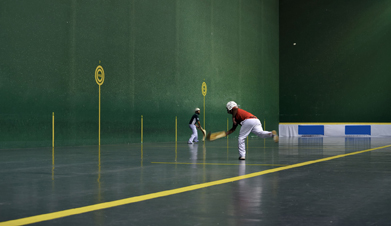Lesson 2
1. Lesson 2
Module 6: Rational Expressions
Lesson 2: Multiplying and Dividing Rational Expressions
Focus

© Tilio & Paolo/18284919/Fotolia
What’s your favourite game or sport that is played on a court? Basketball, volleyball, and tennis are played on courts. Most court sports are team games, where members of the same team co-operate to score points against the other team. Some of these games may also be played without the co-operative aspect and instead be played one-on-one.
Jai alai is a sport with Spanish origins played on a large rectangular court called a fronton. The court consists of a floor that can extend up to 200 ft in length and includes three wall surfaces. Players in jai alai bounce a special ball off the front wall using a custom-made basket that is attached to the wrist. A player earns a point if the opponent fails to catch the ball when it rebounds. Known as the fastest sport on Earth and also described as “ballet with bullets,” jai alai is a sport that can be played one-on-one or with pairs.
In this lesson you will learn how to multiply and divide rational expressions. You will use rational expressions to model the dimensions of the courts in various sports and games, including jai alai.
Outcomes
At the end of this lesson you will be able to
- compare the strategies for multiplying and dividing rational expressions to the strategies for multiplying and dividing rational numbers
- determine the non-permissible values when multiplying and dividing rational expressions
- determine, in simplified form, the product or quotient of rational expressions
Lesson Questions
You will investigate the following questions:
- How are multiplying and dividing rational expressions similar to multiplying and dividing rational numbers?
- How are non-permissible values determined when multiplying and dividing rational expressions?
Assessment
Your assessment may be based on a combination of the following tasks:
- completion of the Lesson 2 Assignment (Download the Lesson 2 Assignment and save it in your course folder now.)
- course folder submissions from Try This and Share activities
- additions to Module 6 Glossary Terms and Formula Sheet
- work under Project Connection